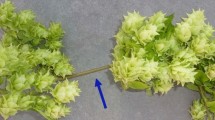Summary
When young plants of Hordeum vulgare. Bryonia dioica. Cucumis sativus. Phaseolus vulgaris. Mimosa pudica. and Ricinus communis. were given a gentle mechanical stimulus by rubbing the internodes for about 10 s once or twice daily, elongation was significantly retarded. Plants of Cucurbita pepo Pisum sativum and Triticum aestivum did not exhibit any such response. The initial response to rubbing was very rapid, elongation stopping less than 3 min after application of the stimulus. When the stimulus was discontinued after 7 days, elongation accelerated, reaching a normal or supernormal rate within 3 or 4 days. Mechanical stimulation also affected aspects of growth and development other than stem elongation. In Mimosa pudica, flower bud production was retarded, as was the growth of the tendrils, leaves, and petioles in Bryonia dioica. It is suggested that this response be called thigmomorphogenesis, and that it represents an adaptation designed to protect plants from the stresses produced by high winds and moving animals. Some evidence indicates that thigmomorphogenesis may be mediated by ethylene.
Similar content being viewed by others
References
Boyer, N.: Modifications de la croissance de la tige de Bryone (Bryonia dioica) à la suite d'irritations tactiles. C. R. Acad. Sci. (Paris) 264 ser. D, 2114–2117 (1967)
Burden, R.F., Randerson, P.F.: A quantitative study of human trampling on vegetation as an aid to the management of semi-natural areas. J. Appl. Ecol. 9, 439–458 (1972)
Burg, S.P., Burg, E.A.: Interaction between auxin and ethylene and its role in plant growth. Proc. nat. Acad. Sci. (Wash.) 55, 262–269 (1966)
Darwin, C.: The power of movement in plants. New York: Appleton 1881
Evans, M., Ray, P.: Timing of the auxin response in coleoptiles and its implications regarding auxin action. J. gen. Physiol. 53, 1–20 (1969)
Holm, R.E., Abeles, F.B.: The role of ethylene in 2,4-D-induced growth inhibition. Planta (Berl.) 78, 293–304 (1968)
Jacobs, M.R.: The effect of wind sway on the form and development of Pinus radiata D. Don. Austr. J. Bot. 2, 35–51 (1954)
Jaffe, M.J.: Physiological studies on pea tendrils. VI. The characteristics of sensory perception and transduction. Plant Physiol. 45, 756–760 (1970)
Jaffe, M.J.: Physiological studies on pea tendrils. VIII. The relationship of circumnutation to contact coiling. With a description of a laboratory intervalometer using integrated digital circuits. Physiologia Plantarum (Cph.) 26, 73–80 (1972)
Jaffe, M.J., Galston, A.W.: Physiological studies on pea tendrils. I. Growth and coiling following mechanical stimulation. Plant Physiol. 41, 1014–1025 (1966)
Jaffe, M.J., Galston, A.W.: The physiology of tendrils. Ann. Rev. Plant Physiol. 19, 417–434 (1968)
Jaffe, M.J., Isenberg, F.M.R.: Some effects on N-dimethyl amino succinamic acid (B-Nine) on the development of various plants, with special reference to the cucumber, Cucumis sativus L. Proc. Amer. Soc. Hort. Sci. 87, 420–428 (1965)
Milburn, J.A.: Phloem exudation from castor bean: induction by massage. Planta (Berl.) 95, 272–276 (1970)
Milburn, J.A.: An analysis of the response in phloem exudation on application of massage to Ricinus. Planta (Berl.) 100, 143–154 (1971)
Neel, P.L., Harris, R.W.: Motion-induced inhibition of elongation and induction of dormancy in Liquidamber. Science 173, 58–59 (1971)
Pickard, B.G.: Action potentials resulting from mechanical stimulation of pea epicotyls. Planta (Berl.) 97, 106–115 (1971)
Salisbury, F.B.: The flowering process. New York: Macmillan 1963
Sibaoka, T.: Physiology of rapid movements in higher plants. Ann. Rev. Plant Physiol. 20, 165–184 (1969)
Turgeon, R., Webb, J.A.: Growth inhibition by mechanical stress. Science 174, 961–962 (1971)
Author information
Authors and Affiliations
Rights and permissions
About this article
Cite this article
Jaffe, M.J. Thigmomorphogenesis: The response of plant growth and development to mechanical stimulation. Planta 114, 143–157 (1973). https://doi.org/10.1007/BF00387472
Received:
Issue Date:
DOI: https://doi.org/10.1007/BF00387472




